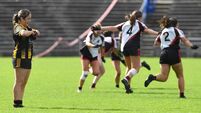FRC has done the GAA some service

At last Saturday's GAA Special Congress in Croke Park were, from right to left, Britain GAA President Sean Hopkins, a Manchester native whose mother Maureen (nee Padden) is a native of Crossmolina, Connacht Council president Vincent Neary from Bonniconlon, Ulster Council chairman Michael Geoghegan, Ard Stiúrthóir of the GAA Tom Ryan, GAA President Jarlath Burns, Leinster Council chairman Derek Kent, Munster Council chairman Tim Murphy and GAA trustee Tracey Kennedy. Picture: INPHO/Tom Maher
It wasn’t a good weekend on the political front for Jim Gavin, but he can take some solace in the fact that his Football Review Committee's work in Gaelic football received a ringing endorsement from delegates across the country.
It should be noted that the passing of all 61 motions relating to their work around the new Gaelic football rule enhancements in a landslide underlines how much of a success those new ideas have been.
Change within the GAA, as many involved in the association will attest, is incredibly hard to achieve. One only has to look at various other changes that have taken place in the past – the decision to allow soccer and rugby be played in Croke Park took quite a degree of political manoeuvring 20-odd years ago before going through – so a root and branch reform of the game of Gaelic football itself required quite a bit of work.
To get through these rule enhancements in such an emphatic manner this year is a remarkable achievement in itself. It’s nearly a greater achievement than actually creating the new rules themselves!
And the landslide with which delegates backed the proposals at the weekend is reflective of the general consensus around this year’s football fare: it is a game reborn.
Jarlath Burns, the GAA President, also deserves credit. He wasted little time in getting stuck into the shortcomings in Gaelic football over the last decade or so, and made clear his intention to give the FRC free-reign when it came to root and branch reform in Gaelic Football.
“We knew that this game of Gaelic football needed serious surgery if it was going to be the game that we knew it could become, and now it has,” Burns told GAA.ie last Saturday.
“We’ve watched a full year of the game being played at all levels and we really like what we see.”
Mayo’s James Horan, Donegal’s Michael Murphy and others involved in the process in formulating these new enhancements deserve real credit, too. Their input, having had a real live experience of the game as it was, was clearly invaluable.
Supporters like it too, with evidence in several quarters this year of increased attendances at inter-county level. For example, there was a 20-percent increase in attendances in the inter-county football championships this year to more than a million spectators when compared with the same figure of approximately 860-thousand in 2024. League attendances were also up.
Why are people so enamoured with the new form of the game?
For the most part, it has introduced the sense of anything being possible and a loss of control. Take the 2024 All-Ireland final, for example, where both Galway and Armagh appeared to be playing risk-averse football. Constant periods of over-and-back the field, with little progress, provided the perfect sample of what the FRC was tasked with solving. Now, we have a different type of approach. The rule enhancements have changed the terms of engagement.
Firstly, because of having to keep three players in the opposition half at all times, defending teams have more space to try and cover. That means more space for the attacking team and, therefore, more scoring chances.
The kick-out has now become even more important. Breaking ball is the currency in which teams now deal: break even there and you’re likely to be in for a decent 60 or 70 minutes. With the short kick-out now much less prevalent due to all players having to be outside the arc for a restart, capable fielders in the middle of the park are now a much more useful asset than they might have been 12 months ago. That’s a return to the importance of high-fielding – one of the USPs of football in years gone by.
However, one rule that has perhaps gone under the radar but has become a key part of the game is that defending teams cannot pass the ball back to their goalkeeper. This encourages the attacking team to squeeze right up on the kick-out, and in passages of play when defenders are playing keep ball in their own half. That leads to mistakes, scoring chances and excitement for the crowd.
And, of course, the two-point arc has become a massive part of things now, rewarding teams with players who have the ability to kick a long-range score. It can move the scoreboard quickly and effectively.
There are other rule enhancements that have added other elements to the game that we hadn’t before, but the aforementioned changes, to me at least, appear to be the most impactful and the most significant. The freshness provided by that has reinvigorated various factions within the sport: the vast majority of players are enthused to get out there and play a more open brand of football that rewards adventure and ambition; coaches are using their best innovation skills to try and coach the new rules to best take advantage of them and supporters are interested to a greater extent than in recent memory.
And, by and large, any concerns over the rollout of the new enhancements to the club game have been greatly exaggerated. Yours truly was among a cohort that felt it may have been a bit of stretch to expect club officials deal with the demands being placed on them with the new enhancements but, if anything, the opposite has been the case. Plus, the rules around dissent have virtually removed any sense of officials being disrespected. It’s certainly much less prevalent than it was in years past.
It’ll be fascinating to see over the coming months, once the club season has concluded and the inter-county one returns, how teams adapt now they’ve had a year of playing the new style of football and having had a winter to pore over the data from it. There are so many good coaches involved nowadays that it’s impossible to imagine someone, somewhere, won’t find a way to figure it all out.
As their time in the spotlight comes to a close, the FRC can reflect on a job very well done.






